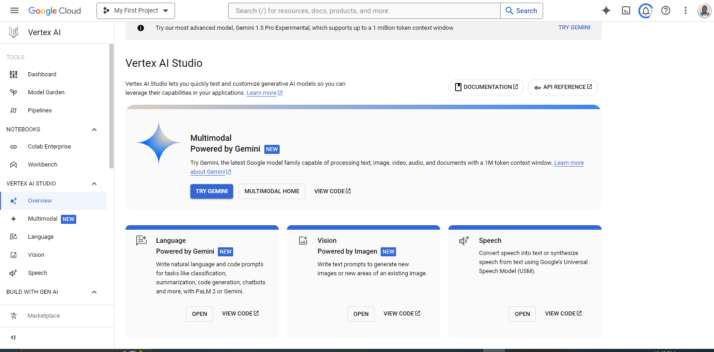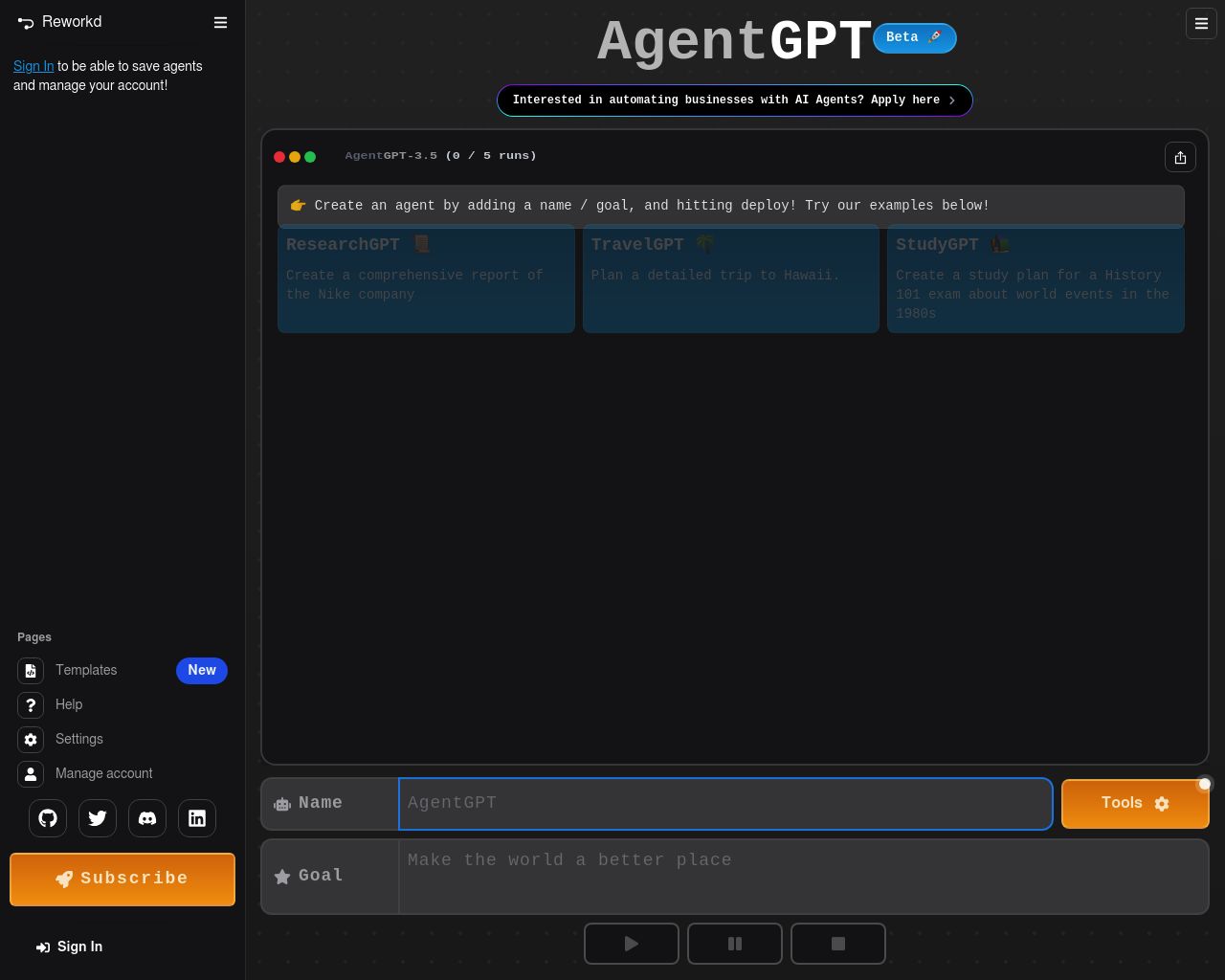Vertex AI vs. AgentGPT: Comparing AI Development Platforms
AI platforms empower developers and businesses to build sophisticated applications, but choosing the right solution can be challenging. This comparison of Vertex AI vs. AgentGPT, and SmythOS reveals key differences in functionality, ease of use, and deployment options. Vertex AI offers robust enterprise-scale machine learning tools integrated with Google Cloud. AgentGPT provides a user-friendly web interface for creating autonomous AI agents. SmythOS combines powerful features with exceptional flexibility, catering to both technical experts and newcomers. By examining each platform’s strengths and limitations, you’ll gain insights to select the AI development environment that best fits your needs, whether you’re a seasoned developer, business leader, or AI enthusiast.
Vertex AI Overview
Vertex AI empowers developers and businesses to build, deploy, and scale machine learning models and AI applications. This comprehensive platform integrates advanced tools for data preparation, model training, and deployment, streamlining the entire AI development lifecycle.


Screenshot from Vertex AI studio.
Vertex AI’s standout feature is its support for multimodal generative AI models, particularly Gemini. These models process diverse inputs including text, images, audio, and video, enabling the creation of sophisticated AI agents for tasks ranging from chatbots to content generation. The platform’s Model Garden offers a rich selection of pre-trained models, including Google’s proprietary offerings and select open-source options, allowing users to quickly find and customize AI solutions for their specific needs.
Vertex AI’s standout feature is its support for multimodal generative AI models, particularly Gemini. These models process diverse inputs including text, images, audio, and video…
For enterprises and development teams, Vertex AI provides robust MLOps capabilities. Its centralized model registry, feature store, and integrated monitoring tools facilitate efficient model management and performance tracking. The platform also emphasizes scalability and security, with features like auto-scaling for deployments and data encryption to protect sensitive information.
While Vertex AI offers powerful capabilities, it requires a certain level of technical expertise to fully utilize. Unlike some competitors, it doesn’t provide a no-code editor, which may limit accessibility for non-technical users. However, for those with the necessary skills, Vertex AI’s comprehensive suite of tools and integration with Google Cloud services make it a formidable choice for building and deploying AI solutions at scale.
AgentGPT Overview
AgentGPT empowers users to create and deploy autonomous AI agents directly in a web environment. Unlike traditional chatbots, AgentGPT focuses on goal-oriented tasks, offering a versatile platform for both simple and complex operations.


The platform stands out with its user authentication systems, agent run saving and sharing capabilities, and dynamic translations. AgentGPT’s integration of vector databases for memory management enhances AI agent functionality, allowing them to retain execution history and access long-term memory. This feature proves particularly valuable for tasks requiring contextual understanding and continuity.
AgentGPT’s integration of vector databases for memory management enhances AI agent functionality, allowing them to retain execution history and access long-term memory.
AgentGPT’s web-based nature sets it apart from locally-operated alternatives, offering accessibility without the need for complex setups. The platform scales efficiently through its cloud offering, integrating seamlessly with tools like LangChain. This scalability makes AgentGPT suitable for a wide range of users, from individual developers to large enterprises seeking to streamline operations.
While AgentGPT offers impressive capabilities, it may present a learning curve for users new to AI agent development. The platform’s web-based nature, while convenient, might limit some advanced customization options compared to locally-run alternatives. Additionally, as with any cloud-based service, users should consider data privacy and security implications when handling sensitive information.
AgentGPT’s commitment to continuous evolution, driven by community contributions, positions it as a dynamic player in the AI agent development space. Its focus on making advanced AI technology accessible aligns with the growing trend of AI democratization, potentially opening new avenues for innovation across various industries.
Feature Comparison
Vertex AI and AgentGPT offer distinct approaches to AI development and deployment. Vertex AI provides a comprehensive suite of tools for machine learning and AI model development, with robust support for enterprise-scale deployments. Its standout features include advanced MLOps capabilities, a centralized model registry, and integration with Google Cloud services. Vertex AI excels in multimodal AI, supporting diverse inputs like text, images, audio, and video through models like Gemini.
AgentGPT, in contrast, focuses on creating autonomous AI agents in a web-based environment. It emphasizes accessibility and ease of use, allowing users to deploy AI agents without extensive coding knowledge. AgentGPT’s key strengths lie in its user-friendly interface, the ability to save and share agent runs, and dynamic translations. While both platforms support AI agent development, AgentGPT’s approach is more streamlined for rapid deployment of goal-oriented agents, whereas Vertex AI offers deeper customization and integration options for complex AI systems.
Feature Comparison Table
| Vertex AI | AgentGPT | SmythOS | |
|---|---|---|---|
| CORE FEATURES | |||
| Visual Builder | ✅ | ❌ | ✅ |
| No-Code Options | ❌ | ❌ | ✅ |
| Explainability & Transparency | ✅ | ❌ | ✅ |
| Human-AI Interaction | ✅ | ❌ | ✅ |
| Audit Logs for Analytics | ❌ | ✅ | ✅ |
| SECURITY | |||
| Constrained Alignment | ✅ | ❌ | ✅ |
| IP Control | ✅ | ❌ | ✅ |
| COMPONENTS | |||
| Foundation AIs | ✅ | ❌ | ✅ |
| Huggingface AIs | ❌ | ✅ | ✅ |
| Zapier APIs | ❌ | ✅ | ✅ |
| Data Lakes | ✅ | ❌ | ✅ |
| DEPLOYMENT OPTIONS (EMBODIMENTS) | |||
| Staging Domains | ✅ | ❌ | ✅ |
| Production Domains | ✅ | ❌ | ✅ |
| Deploy as Scheduled Agent | ✅ | ❌ | ✅ |
| DATA LAKE SUPPORT | |||
| Sitemap Crawler | ❌ | ❌ | ✅ |
| YouTube Transcript Crawler | ❌ | ❌ | ✅ |
Best Alternative to Vertex AI and AgentGPT
SmythOS emerges as the superior alternative to Vertex AI and AgentGPT, offering a comprehensive AI automation platform that combines power with accessibility. We designed SmythOS to streamline the creation and deployment of AI agents, making advanced AI capabilities available to users of all skill levels.
Our platform’s intuitive drag-and-drop interface sets it apart from both Vertex AI and AgentGPT. While Vertex AI caters to advanced users with its complex MLOps tools, and AgentGPT focuses on web-based autonomous agents, SmythOS bridges the gap by providing a visual builder that simplifies the development process without sacrificing functionality. This approach democratizes AI development, allowing both technical and non-technical users to create sophisticated AI solutions.
SmythOS bridges the gap by providing a visual builder that simplifies the development process without sacrificing functionality. This approach democratizes AI development…
SmythOS excels in its feature set, offering capabilities that outshine both Vertex AI and AgentGPT. Our platform supports a wide range of AI models, including those from OpenAI, Anthropic, and Hugging Face, providing flexibility that Vertex AI’s Google-centric approach lacks. Unlike AgentGPT’s limited scope, SmythOS enables the creation of multi-agent systems that can collaborate on complex tasks, mirroring human team dynamics.
The deployment options in SmythOS surpass those of both competitors. While Vertex AI focuses on Google Cloud integrations and AgentGPT offers web-based deployment, SmythOS provides versatile options including API endpoints, webhooks, scheduled agents, and even ChatGPT plugins. This flexibility ensures that AI solutions built with SmythOS can seamlessly integrate into existing workflows and systems across various platforms.
SmythOS stands out in its commitment to scalability and enterprise-readiness. We offer robust security features, including data encryption and OAuth support, addressing the concerns that businesses might have when considering AgentGPT’s open-source model. Our platform’s ability to handle large-scale deployments rivals Vertex AI’s capabilities while maintaining the user-friendly approach that AgentGPT users appreciate.
Conclusion
Vertex AI, AgentGPT, and SmythOS each offer unique approaches to AI development and deployment. Vertex AI excels in enterprise-scale machine learning with robust MLOps capabilities and integration with Google Cloud services. AgentGPT provides an accessible web-based platform for creating autonomous AI agents, ideal for rapid deployment of goal-oriented tasks.
However, SmythOS emerges as the superior choice, combining the strengths of both platforms while addressing their limitations. Our drag-and-drop interface democratizes AI development, making it accessible to both technical and non-technical users. Unlike Vertex AI, which requires significant technical expertise, SmythOS enables quick creation and deployment of sophisticated AI agents without extensive coding knowledge.
SmythOS surpasses AgentGPT’s capabilities with its comprehensive feature set, including multi-agent collaboration, advanced debugging tools, and seamless integration with over 300,000 APIs and services. Our platform’s “Create Once, Deploy Anywhere” philosophy allows for unparalleled flexibility, enabling deployment across various environments from chatbots to APIs.
For businesses and developers seeking to harness the full potential of AI, SmythOS offers the most comprehensive and user-friendly solution. We invite you to experience the future of AI development by creating a free SmythOS account today. Unlock limitless possibilities with our powerful platform and join the AI revolution that’s transforming industries worldwide.
Last updated:
Disclaimer: The information presented in this article is for general informational purposes only and is provided as is. While we strive to keep the content up-to-date and accurate, we make no representations or warranties of any kind, express or implied, about the completeness, accuracy, reliability, suitability, or availability of the information contained in this article.
Any reliance you place on such information is strictly at your own risk. We reserve the right to make additions, deletions, or modifications to the contents of this article at any time without prior notice.
In no event will we be liable for any loss or damage including without limitation, indirect or consequential loss or damage, or any loss or damage whatsoever arising from loss of data, profits, or any other loss not specified herein arising out of, or in connection with, the use of this article.
Despite our best efforts, this article may contain oversights, errors, or omissions. If you notice any inaccuracies or have concerns about the content, please report them through our content feedback form. Your input helps us maintain the quality and reliability of our information.
